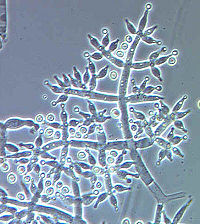
Photo from wikipedia
Transcriptional regulators are able to integrate extracellular nutrient signals and exert a combinatorial control over various metabolic genes. A plethora of such factors therefore constitute a complex regulatory network ensuring… Click to show full abstract
Transcriptional regulators are able to integrate extracellular nutrient signals and exert a combinatorial control over various metabolic genes. A plethora of such factors therefore constitute a complex regulatory network ensuring rapid and accurate cellular response to acquire and utilize nutrients. ABSTRACT The filamentous fungus Trichoderma reesei is one of the most prolific cellulase producers and has been established as a model microorganism for investigating mechanisms modulating eukaryotic gene expression. Identification and functional characterization of transcriptional regulators involved in complex and stringent regulation of cellulase genes are, however, not yet complete. Here, a Zn(II)2Cys6-type transcriptional factor TAM1 that is homologous to Aspergillus nidulans TamA involved in nitrogen metabolism, was found not only to regulate ammonium utilization but also to control cellulase gene expression in T. reesei. Whereas Δtam1 cultivated with peptone as a nitrogen source did not exhibit a growth defect that was observed on ammonium, it was still significantly compromised in cellulase biosynthesis. The absence of TAM1 almost fully abrogated the rapid cellulase gene induction in a resting-cell-inducing system. Overexpression of gdh1 encoding the key ammonium assimilatory enzyme in Δtam1 rescued the growth defect on ammonium but not the defect in cellulase gene expression. Of note, mutation of the Zn(II)2Cys6 DNA-binding motif of TAM1 hardly affected cellulase gene expression, while a truncated ARE1 mutant lacking the C-terminal 12 amino acids that are required for the interaction with TAM1 interfered with cellulase biosynthesis. The defect in cellulase induction of Δtam1 was rescued by overexpression of the key transactivator for cellulase gene, XYR1. Our results thus identify a nitrogen metabolism regulator as a new modulator participating in the regulation of induced cellulase gene expression. IMPORTANCE Transcriptional regulators are able to integrate extracellular nutrient signals and exert a combinatorial control over various metabolic genes. A plethora of such factors therefore constitute a complex regulatory network ensuring rapid and accurate cellular response to acquire and utilize nutrients. Despite the in-depth mechanistic studies of functions of the Zn(II)2Cys6-type transcriptional regulator TamA and its orthologues in nitrogen utilization, their involvement in additional physiological processes remains unknown. In this study, we demonstrated that TAM1 exerts a dual regulatory role in mediating ammonium utilization and induced cellulase production in the well known cellulolytic fungus Trichoderma reesei, suggesting a potentially converged regulatory node between nitrogen utilization and cellulase biosynthesis. This study not only contributes to unveiling the intricate regulatory network underlying cellulase gene expression in cellulolytic fungus but also helps expand our knowledge of fungal strategies to achieve efficient and coordinated nutrient acquisition for rapid propagation.
Journal Title: Applied and Environmental Microbiology
Year Published: 2023
Link to full text (if available)
Share on Social Media: Sign Up to like & get
recommendations!